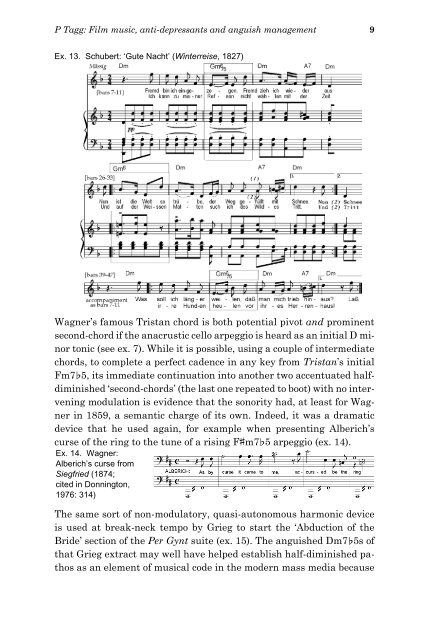Film music, antidepressants and anguish management - Philip Tagg
Film music, antidepressants and anguish management - Philip Tagg
Film music, antidepressants and anguish management - Philip Tagg
Create successful ePaper yourself
Turn your PDF publications into a flip-book with our unique Google optimized e-Paper software.
P <strong>Tagg</strong>: <strong>Film</strong> <strong>music</strong>, anti-depressants <strong>and</strong> <strong>anguish</strong> <strong>management</strong> 9<br />
Ex. 13. Schubert: ‘Gute Nacht’ (Winterreise, 1827)<br />
Wagner’s famous Tristan chord is both potential pivot <strong>and</strong> prominent<br />
second-chord if the anacrustic cello arpeggio is heard as an initial D minor<br />
tonic (see ex. 7). While it is possible, using a couple of intermediate<br />
chords, to complete a perfect cadence in any key from Tristan’s initial<br />
Fm7$5, its immediate continuation into another two accentuated halfdiminished<br />
‘second-chords’ (the last one repeated to boot) with no intervening<br />
modulation is evidence that the sonority had, at least for Wagner<br />
in 1859, a semantic charge of its own. Indeed, it was a dramatic<br />
device that he used again, for example when presenting Alberich’s<br />
curse of the ring to the tune of a rising F#m7$5 arpeggio (ex. 14).<br />
Ex. 14. Wagner:<br />
Alberich’s curse from<br />
Siegfried (1874;<br />
cited in Donnington,<br />
1976: 314)<br />
The same sort of non-modulatory, quasi-autonomous harmonic device<br />
is used at break-neck tempo by Grieg to start the ‘Abduction of the<br />
Bride’ section of the Per Gynt suite (ex. 15). The <strong>anguish</strong>ed Dm7$5s of<br />
that Grieg extract may well have helped establish half-diminished pathos<br />
as an element of <strong>music</strong>al code in the modern mass media because














